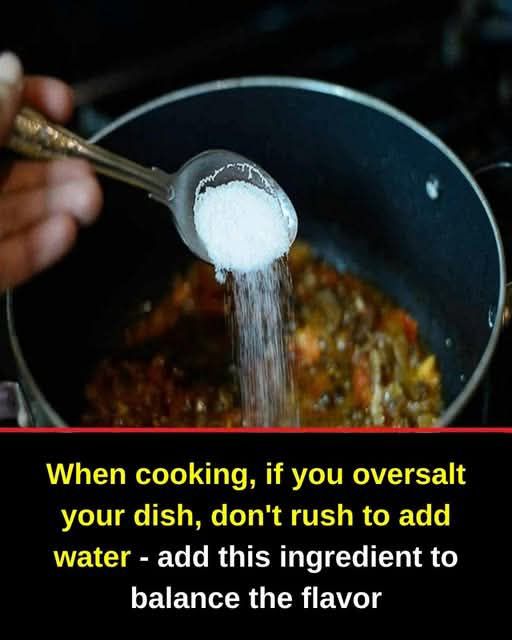ADVERTISEMENT
Tips for Handling if the Dish is Too Salty: Quick Fixes for a Balanced Flavor
It happens to the best of us—after hours of preparing a delicious meal, you take a bite and realize the dish is too salty! Whether it’s a hearty soup, a batch of pasta sauce, or a savory stir-fry, an over-salted dish can quickly turn a meal into a disappointment. But fear not! There are plenty of ways to salvage your food and restore balance to the flavor without starting from scratch.
In this article, we’ll provide you with practical tips and tricks for handling an over-salted dish, so you can still serve a flavorful, enjoyable meal without the excess sodium.
1. Dilute the Dish with Water or Broth
The quickest way to reduce the saltiness in a liquid-based dish, like soup, stew, or sauce, is to dilute it. Adding more water or low-sodium broth helps to spread out the salty flavors and create a more balanced taste.
Tip: If you’re adding water or broth, make sure to taste as you go and add a little at a time. Too much liquid could water down the entire flavor, so you want to adjust gradually. If your dish is already rich in flavor, adding broth instead of water can help maintain the depth of taste.
2. Add Acid to Balance the Flavor
Acidic ingredients can help balance out excessive saltiness by providing contrast to the dish. Common acids like lemon juice, vinegar, or tomato can work wonders in cutting through the salt and making the dish taste more rounded.
- For soups or stews: A splash of vinegar or a squeeze of lemon juice can bring brightness and balance to the flavor.
- For pasta sauces or casseroles: Consider adding a bit of tomato paste, lemon zest, or a dash of balsamic vinegar.
Tip: Use acid sparingly—start with a little, and adjust to taste. You don’t want to turn your dish too tangy, but rather create a harmonious contrast with the salty flavors.
3. Add More Ingredients
If your dish is too salty, sometimes the easiest solution is to add more ingredients to bulk up the dish and dilute the saltiness. This approach works especially well with soups, stews, casseroles, or stir-fries.
- Vegetables: Add chopped potatoes, carrots, spinach, or mushrooms. These vegetables can absorb some of the salt and provide extra volume, making the dish more balanced.
- Starches: Add cooked rice, pasta, or noodles to absorb the saltiness while enhancing the texture of the dish.
- Beans: Beans are another great addition to absorb excess salt and give your dish a heartier feel.
Tip: When adding more ingredients, make sure they complement the dish. You don’t want to overfill the pot or alter the flavor profile too much, but adding just enough will help counteract the salt.
4. Balance with Sweetness
Sweetness can often counteract excessive saltiness, particularly in dishes like sauces or soups. A small amount of sugar, honey, or maple syrup can neutralize the salty taste and create a more harmonious flavor.
- For tomato-based sauces: A teaspoon of sugar can balance the acidity and saltiness.
- For soups or stews: A drizzle of honey or maple syrup can add sweetness and help mellow the flavor.
Tip: Be cautious when adding sweetness. You don’t want to make the dish too sweet—just a small amount can do the trick. Always taste and adjust gradually.
5. Add a Starchy Ingredient
Starches, such as potatoes, rice, or pasta, can absorb some of the salt and dilute its intensity. If your dish is a soup or stew, adding diced potatoes and letting them cook for a few minutes can help absorb some of the saltiness.
For non-liquid dishes, you can also serve the salty dish with a side of rice or pasta to help balance the overall flavor.
Tip: For soups or stews, add raw, peeled potatoes and let them cook in the liquid for 10-15 minutes. They’ll soak up some of the excess salt, and you can remove them later if you wish.
6. Add Dairy for Creaminess and Balance
Dairy products like cream, milk, yogurt, or cheese can help mellow out the saltiness in dishes like pasta sauces, curries, or casseroles. Dairy has a neutralizing effect on salty flavors, making the dish taste smoother and more balanced.
- For creamy soups or sauces: Add a splash of cream or milk to tone down the salt.
- For curries or casseroles: A dollop of yogurt or sour cream can help to reduce the salty kick.
Tip: If you’re working with a dairy-free recipe, coconut milk or cashew cream can be a good alternative to add creaminess without the dairy.
For Complete Cooking STEPS Please Head On Over To Next Page Or Open button (>) and don’t forget to SHARE with your Facebook friends
